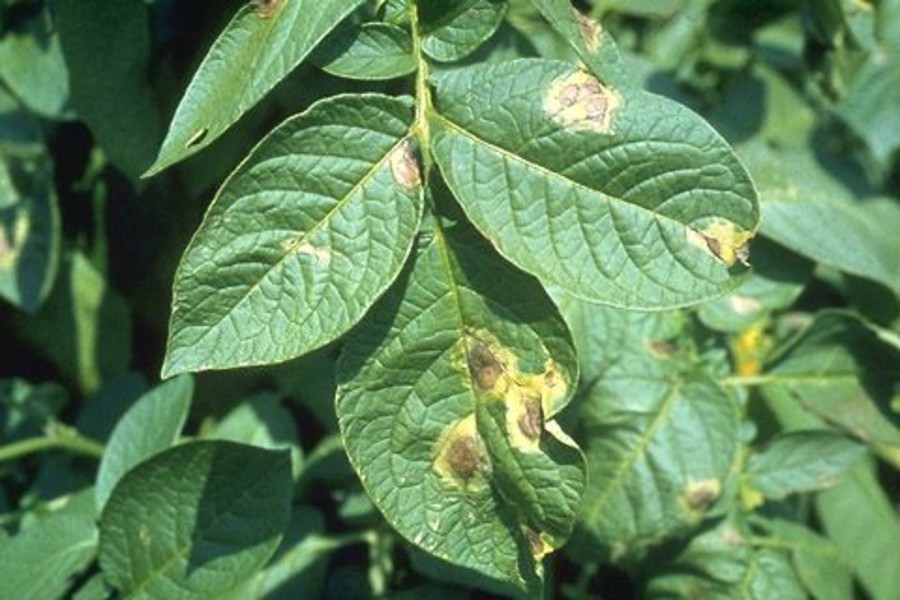Potato pests and diseases can affect your harvest, or worse, ruin your soil and other crops.
Potatoes can be affected by various pests, and fungal and viral infections.
Pests
Cutworm: This caterpillar causes damage to young shoots which will often wilt suddenly and die. Cutworms are the greyish, hairless caterpillars produced by a moth. They are often troublesome in the seedbed and a threat to newly transplanted potatoes. They come out at night to feed on the stem of the plant, cutting it off from the roots. If you only have a few plants, you can wrap paper collars round the base of the plant. You can remove them manually at night. Try sprinkling diatomaceous earth around the plants. There are also eco-friendly insecticides for these worms. Plant lettuce, spinach, broccoli, cabbage and cauliflower amongst your potato plants, as they repel the cutworms.

Tubermoth: This is a nocturnal insect most damaging to your crop during its larvae stage. They can also attack tubers you have harvested and are storing. The larvae tunnel through the plant tissue, mostly favouring those parts of the plant that are above or just below the surface. Tubers deeper down do not appear to be affected by the tubermoth larvae. When eating tubers, the larvae leave behind debris, making the tubers inedible and also unable to be grafted for planting. Building ridges around your plants mean as little of the plant is exposed to the larvae as possible. If you have done this, maintain your ridges by ensuring they have not dried out to the point of cracks appearing, as this will only allow a pathway for the larvae into your plant.
Snails and slugs: During wet periods, you may struggle with snails and slugs. Diatomaceous earth can be used sprinkle on the top of the soil. Granular or liquid snail baits are also available and work best when sprinkled at night. Some of these are sweetened with molasses and can therefore be attractive to your dogs ~ keep your pets away from your garden.
Aphids: this common garden pest can also affect your potatoes.
Diseases
As many diseases can be carried in the tuber of a potato, it is vital you choose your seed potatoes very carefully when it comes time to plant. Use ‘clean’ seed potatoes, preferably certified from reputable sellers. Avoid simply cutting up a grocery-store potato in the hopes of growing your own ~ some potato diseases can irreparably damage your soil and you will regret not having taken the care to obtain proper seed potatoes.

Late blight: Sometimes also known as ‘roes’, this is a fungal disease. The disease occurs later in the growing season, hence the name, and first appears as brown or grey-green water-soaked markings on the leaves, usually at the leaf edges on lower leaves which are the oldest on the plant. As the disease matures, these marks will become darker and a white fungal growth begins to grow on the undersides of the leaves. Eventually, the whole plant will be overcome.
Late blight is introduced into your soil by infected tubers so care must be taken when buying or choosing tubers to plant. If infection is found on one or two plants, remove those infected and burn them.
In warm climates, the disease can spread quickly, killing your crops within ten days. If you notice the infection, immediately remove affected plants and cover all cracks in the soil to prevent spores from infecting the soil. You can also cut the uninfected parts of the plant off, leaving the rest to grow but be sure you have removed all evidence of the disease. Avoid walking between affected plants, as your shoes may carry spores from diseased to healthy plants.
Spacing in planting your potatoes and important and can prove helpful if you end up having to deal with late blight.
Other diseases to look out for are bacterial wilt, soft rot/blackleg and powdery scab. Potatoes can also be affected by viral diseases.
This is part of a series on growing vegetables from the nightshade family. For more, click here. If you enjoyed this article, subscribe to receive more like this.

